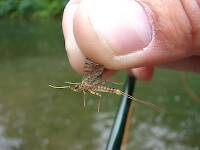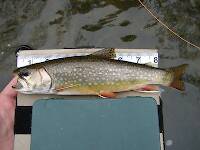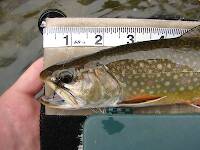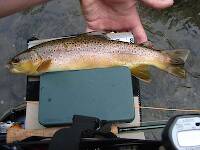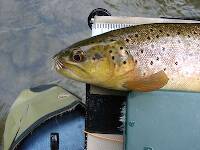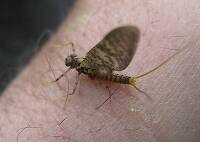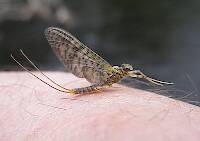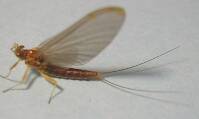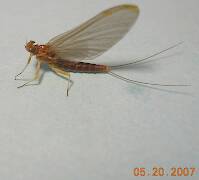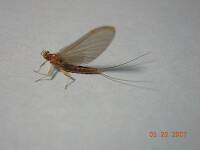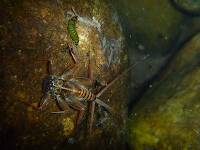
Blue-winged Olives
Baetis
Tiny Baetis mayflies are perhaps the most commonly encountered and imitated by anglers on all American trout streams due to their great abundance, widespread distribution, and trout-friendly emergence habits.
Featured on the forum

This is an interesting one. Following the keys in Merritt R.W., Cummins, K.W., and Berg, M.B. (2019) and Jacobus et al. (2014), it keys clearly to Ephemerella. Jacobus et al provide a key to species, but some of the characteristics are tricky to interpret without illustrations. If I didn't make any mistakes, this one keys to Ephemerella mucronata, which has not previously been reported any closer to here than Montana and Alberta. The main character seems to fit well: "Abdominal terga with prominent, paired, subparallel, spiculate ridges." Several illustrations or descriptions of this holarctic species from the US and Europe seem to match, including the body length, tarsal claws and denticles, labial palp, and gill shapes. These sources include including Richard Allen's original description of this species in North America under the now-defunct name E. moffatae in Allen RK (1977) and the figures in this description of the species in Italy.

Troutnut is a project started in 2003 by salmonid ecologist Jason "Troutnut" Neuswanger to help anglers and
fly tyers unabashedly embrace the entomological side of the sport. Learn more about Troutnut or
support the project for an enhanced experience here.
Wiflyfisher has attached these 4 pictures to aid in identification. The message is below.
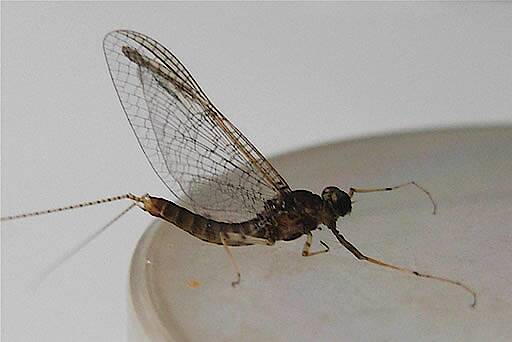
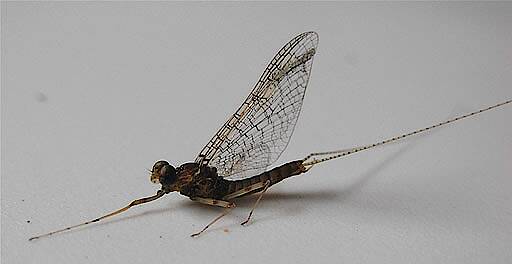
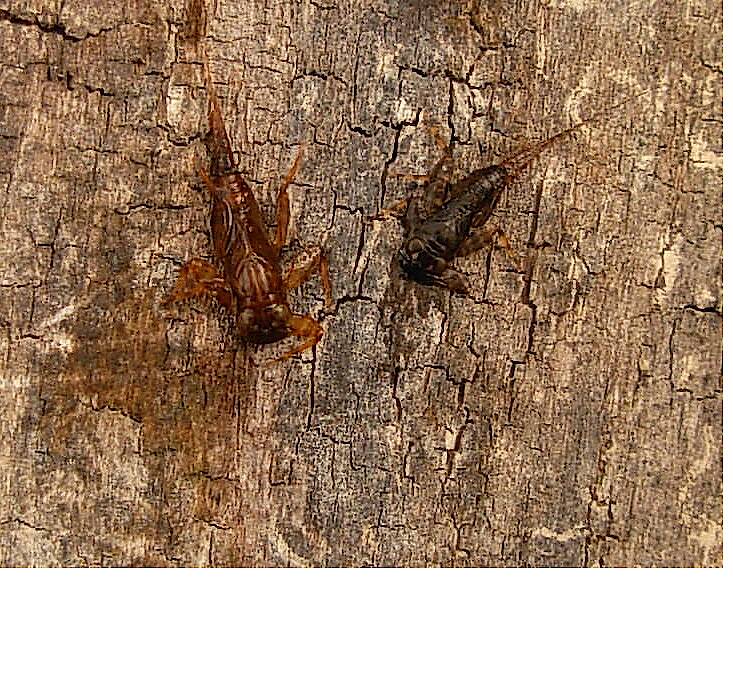
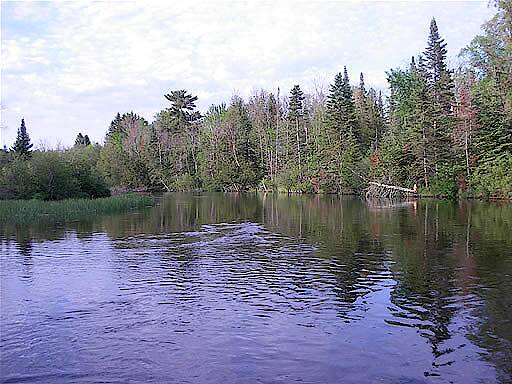
Wiflyfisher on Jun 12, 2008June 12th, 2008, 4:47 pm EDT
Any thoughts as to what this spinner is? My thought is possibly a Siphloplecton specie. I have collected basale before but that has always been early May.
John S.
https://WiFlyFisher.com
https://WiFlyFisher.com
GONZO on Jun 12, 2008June 12th, 2008, 5:22 pm EDT
John,
I believe Siphloplecton should have staining and anastomosis in the stigmatic region (the area around the leading edge toward the top of the wing). Actually, this looks like it might be a Maccaffertium vicarium spinner. Compare this to some of the male spinners Jason has on the vicarium page and see what you think.
I believe Siphloplecton should have staining and anastomosis in the stigmatic region (the area around the leading edge toward the top of the wing). Actually, this looks like it might be a Maccaffertium vicarium spinner. Compare this to some of the male spinners Jason has on the vicarium page and see what you think.
Wiflyfisher on Jun 12, 2008June 12th, 2008, 5:32 pm EDT
Gonzo,
Thanks for thr reply. Although the timing is right for M. vicarium, the color of these spinners is much darker than any Stenonema vicarium spinner I have ever collected and it's abdomen seems to skinny to me. I agree the Siphloplecton should have staining but I couldn't think of anything else that really resemble these guys.
Thanks for thr reply. Although the timing is right for M. vicarium, the color of these spinners is much darker than any Stenonema vicarium spinner I have ever collected and it's abdomen seems to skinny to me. I agree the Siphloplecton should have staining but I couldn't think of anything else that really resemble these guys.
John S.
https://WiFlyFisher.com
https://WiFlyFisher.com
GONZO on Jun 12, 2008June 12th, 2008, 5:50 pm EDT
Yeah, it is dark, but consider how the duns vary in color. Check out the 8th and 10th specimens on the vicarium page. They appear to be as dark and skinny as this one (to me).
Taxon on Jun 12, 2008June 12th, 2008, 6:09 pm EDT
Did you notice the darker alternate joinings of the cerci, and that the front of the head appears to be white? The body does seem too dark for that species, but how about:
Scientific name: Maccaffertium modestum
Previously know as: Ecdyonurus ruber, Ecdyonurus rubromaculatus, Epeorus modestus, Heptagenia modesta, Heptagenia rubromaculata, Iron modestus, Stenonema annexum, Stenonema modestum, Stenonema ruber, Stenonema rubromaculatum, Stenonema rubrum, Stenonema varium
Common name: Cream Cahill
Locality: E, M
Nymphal habitat: gravel riffles of medium sized to large streams, where current is swift, but water is shallow (6 inches or less in depth)
Voltinism:
Emergence (begin) date: early-Jun
Emergence (end) date: mid-Aug
Emergence time of day:
Spinner fall time of day:
Nymph (mature) minimum length: 9 mm.
Nymph maximum length: 11 mm.
Nymph identification keys: posterolateral spines on abdominal segment: (7-9); dark posterior margin on sternites: (no); broad femoral flanging
Nymph body description: tergites dark brown, sternites light brownish olive
Nymph legs: light and dark banding w/wide dark femoral bands
Nymph gills: on segments 1-6, truncate, purplish-gray
Nymph tusks:
Nymph tails: 3, w/dark bands
Dun minimum length: 9 mm.
Dun maximum length: 11 mm.
Dun identification keys:
Dun body description: creamy white w/brown markings on tergites; (former S. rubrum): thorax olive, abdomen patterned w/olive
Dun wings: pale gray; (former S. rubrum): creamy-white, faintly tinged w/green
Dun legs: creamy-white, faintly tinged w/green
Dun tails: 2, pale tan
Spinner minimum length: 8 mm.
Spinner maximum length: 13 mm.
Spinner identification keys: head of male translucent white in front, pale reddish brown above, ocelli prominently ringed w/black
Spinner body description: thorax same as abdomen but w/yellow cast, abdomen whitish to cream to orange-yellow to tan; (former S. rubrum): thorax yellowish, abdomen cream
Spinner wings: hyaline w/slight mottling and dark reddish venation; large hind wings; (former S. rubrum): hyaline w/amber longitudinal veins and brown cross-veins, stigmatic area of fore wings slightly tinged w/pink
Spinner legs: hind tarsi 5-segmented; (former S. modestum): tan banded w/brown markings; (former S. rubrum): femora w/narrow midian and apical bands of dilute purple, tibiae smoky at tip, middle and hind legs nearly white w/femora having very faint median and apical ba
Spinner tails: 2, (former S. modestrum): cream to light tan; (former S. rubrum): white to very pale buff, alternate joinings narrowly dark
Scientific name: Maccaffertium modestum
Previously know as: Ecdyonurus ruber, Ecdyonurus rubromaculatus, Epeorus modestus, Heptagenia modesta, Heptagenia rubromaculata, Iron modestus, Stenonema annexum, Stenonema modestum, Stenonema ruber, Stenonema rubromaculatum, Stenonema rubrum, Stenonema varium
Common name: Cream Cahill
Locality: E, M
Nymphal habitat: gravel riffles of medium sized to large streams, where current is swift, but water is shallow (6 inches or less in depth)
Voltinism:
Emergence (begin) date: early-Jun
Emergence (end) date: mid-Aug
Emergence time of day:
Spinner fall time of day:
Nymph (mature) minimum length: 9 mm.
Nymph maximum length: 11 mm.
Nymph identification keys: posterolateral spines on abdominal segment: (7-9); dark posterior margin on sternites: (no); broad femoral flanging
Nymph body description: tergites dark brown, sternites light brownish olive
Nymph legs: light and dark banding w/wide dark femoral bands
Nymph gills: on segments 1-6, truncate, purplish-gray
Nymph tusks:
Nymph tails: 3, w/dark bands
Dun minimum length: 9 mm.
Dun maximum length: 11 mm.
Dun identification keys:
Dun body description: creamy white w/brown markings on tergites; (former S. rubrum): thorax olive, abdomen patterned w/olive
Dun wings: pale gray; (former S. rubrum): creamy-white, faintly tinged w/green
Dun legs: creamy-white, faintly tinged w/green
Dun tails: 2, pale tan
Spinner minimum length: 8 mm.
Spinner maximum length: 13 mm.
Spinner identification keys: head of male translucent white in front, pale reddish brown above, ocelli prominently ringed w/black
Spinner body description: thorax same as abdomen but w/yellow cast, abdomen whitish to cream to orange-yellow to tan; (former S. rubrum): thorax yellowish, abdomen cream
Spinner wings: hyaline w/slight mottling and dark reddish venation; large hind wings; (former S. rubrum): hyaline w/amber longitudinal veins and brown cross-veins, stigmatic area of fore wings slightly tinged w/pink
Spinner legs: hind tarsi 5-segmented; (former S. modestum): tan banded w/brown markings; (former S. rubrum): femora w/narrow midian and apical bands of dilute purple, tibiae smoky at tip, middle and hind legs nearly white w/femora having very faint median and apical ba
Spinner tails: 2, (former S. modestrum): cream to light tan; (former S. rubrum): white to very pale buff, alternate joinings narrowly dark
GONZO on Jun 12, 2008June 12th, 2008, 6:47 pm EDT
Hi Roger,
Doesn't modestum typically have a mostly white or cream abdomen (with some dark markings on the tergites)?
Doesn't modestum typically have a mostly white or cream abdomen (with some dark markings on the tergites)?
Taxon on Jun 12, 2008June 12th, 2008
Gonzo-
Yes, that's true. But, does it always? I just don't know. However, I do know that it's the only one in my database with a description of alternate dark joinings, so I thought I'd mention it as a possibility, however remote.
Yes, that's true. But, does it always? I just don't know. However, I do know that it's the only one in my database with a description of alternate dark joinings, so I thought I'd mention it as a possibility, however remote.
Wiflyfisher on Jun 13, 2008June 13th, 2008, 1:32 am EDT
Gonzo,
I think you nailed it. I didn't see the second Maccaffertium photo page before. Jason took his photos of the Maccaffertium vicarium spinners on a river in the same area as I got these last night. For some reason I remember Stenonema vicarium spinners as lighter and more color than these. At least I had on the right fly. :)
There was a mixture of E. invaria and M. vicarium above the run last night. Quite a sight to see. Everything is late up here this year and the water is really high.
BTW, I changed the thread title so people searching won't get the wrong results.
Thanks!
I think you nailed it. I didn't see the second Maccaffertium photo page before. Jason took his photos of the Maccaffertium vicarium spinners on a river in the same area as I got these last night. For some reason I remember Stenonema vicarium spinners as lighter and more color than these. At least I had on the right fly. :)
There was a mixture of E. invaria and M. vicarium above the run last night. Quite a sight to see. Everything is late up here this year and the water is really high.
BTW, I changed the thread title so people searching won't get the wrong results.
Thanks!
John S.
https://WiFlyFisher.com
https://WiFlyFisher.com
GONZO on Jun 13, 2008June 13th, 2008, 6:07 am EDT
Lovely water in that last photo, John. With all the rain and flooding in the Midwest, I bet you're counting your blessings that your streams are only "really high." Could be worse, huh?
If your spinners are fairly large (~12-16mm), they probably are vicarium. They can be lighter--just that variability thing. The Maccaffertium nymphs in the new photo might be other species, perhaps the one Roger detailed above. Just guessing, but are they smaller (~9-12mm)?
If your spinners are fairly large (~12-16mm), they probably are vicarium. They can be lighter--just that variability thing. The Maccaffertium nymphs in the new photo might be other species, perhaps the one Roger detailed above. Just guessing, but are they smaller (~9-12mm)?
Wiflyfisher on Jun 13, 2008June 13th, 2008, 10:14 am EDT
The NW corner has not had all the rain that Central and Southern Wisconsin has had. The rivers are all high but in really good condition.
The smaller nymph might be Maccaffertium modestum. The larger reddish nymph I assumed was vicarium.
Thanks again Gonzo and Roger.
The smaller nymph might be Maccaffertium modestum. The larger reddish nymph I assumed was vicarium.
Thanks again Gonzo and Roger.
John S.
https://WiFlyFisher.com
https://WiFlyFisher.com
Quick Reply
Related Discussions
Topic
Replies
Last Reply
5
May 20, 2009
by GONZO
by GONZO
4
May 24, 2008
by Softhackle
by Softhackle
2
May 20, 2007
by Troutnut
by Troutnut
8
Mar 30, 2012
by Brookyman
by Brookyman




